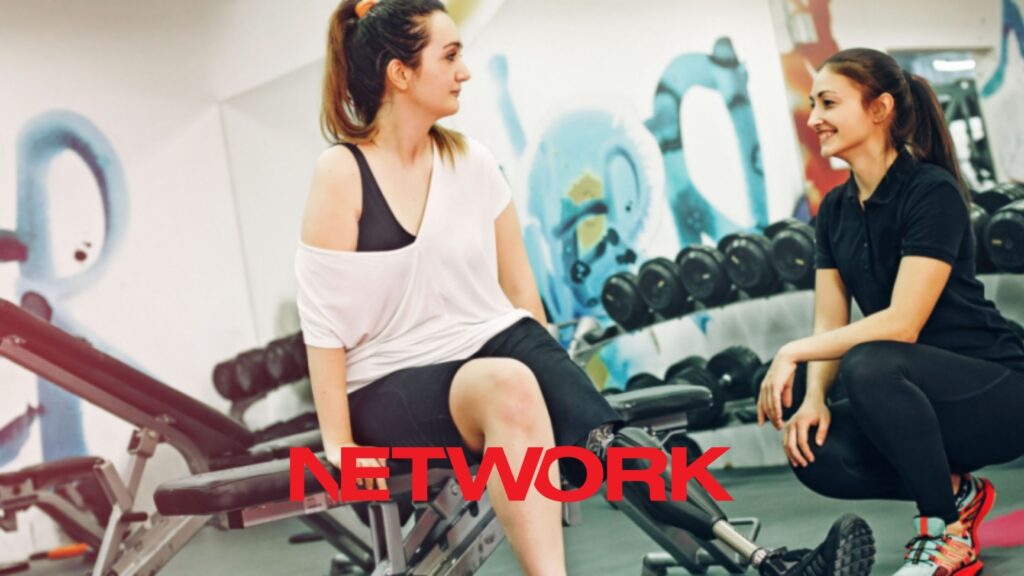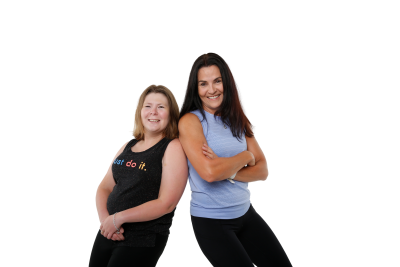The Fitness Zone

Word power: The language of disability
Many of us struggle to know how to speak to people with a disability in our clubs and classes. Fitness professional and disability advocate Carol Syer provides some simple dos and don’ts when it comes to the language of disability.
In my 30+ years working in fitness, I have witnessed our industry grow and mature, and as it’s done so, it has become more aware and more inclusive. We have become better educated, and with that knowledge we are becoming more welcoming for people with disability.
Having spent my life living with someone with a disability, I have never really stumbled over correct language or worried about what to say or do around a person with disability. I often see this awkwardness in others, however, though usually not through any fault of their own. The fact is, we simply don’t know what we don’t know. With clear and friendly communication being essential to the facilitation of safe and effective exercise delivery, it’s worth our while paying some attention to the topic. Here, I’ll explore the role of language and provide some easy-to-understand dos and don’ts when it comes to the language of disability.
Firstly, I want to make it very clear, I do not speak for anyone with a disability – no one can. Every person with a disability is an individual, and there is no check list of ‘say this but don’t say that’ that will cover every person and every situation. The most important thing to remember is individuality. People with disability are professors, teachers, doctors, cleaners, factory workers, unemployed, advocates, mothers, uncles: they are unique.
The power of words
Can you think of a word that was used to describe you at some stage in your life that you hated, or offended you? I can. I was a small-built child and my older brother called me ‘Skinny Ribs’, not in a fun big brotherly way, but in a ‘I’m teasing you mercilessly’ way, and said with offence. Working in the fitness industry I have heard the word skinny used in many ways, from ‘You’re lucky you’re so skinny’ to ‘Oh you can eat anything you want because you’re so skinny’. People think they are paying a compliment, but I find the word offensive because I always wanted to be more muscley.
I know, first world problems, but can you imagine a word used to describe you every day, several times a day, that you don’t want to be associated with constantly? That’s how my daughter Caitlin feels. She has an intellectual disability, but it doesn’t define her. A young adult going about her life like everyone else, she gets sick of the word ‘disability’ and just wants to be seen for herself.
The problem with ableism
Ableism is a term used to describe favouring neurotypical people while excluding and devaluing people living with disability. As such, ableist language is offensive to people with disability. Negative, abusive, derogatory language about disability is ableist. Some words can be offensive in one context, but inoffensive in another. For example, if I use the word ‘normal’ to describe my regular morning routine, that’s fine, but if I’m referring to a person with disability and I compare them or the program or school, for example, to the normal person, program or school, that is offensive. If, for example, you offered an all-abilities children’s class in your facility, but told people that if they didn’t want their kids to attend it, that’s OK because you also offer a normal kids’ class, that would be highly offensive. It’s great that you offer the all-abilities class, but your language around it can thwart your best efforts at making your club more inclusive.
Making offensive terms history
Many words have their roots in the pages of medical history. For example retard, moron, spastic, insane, lunatic, crazy, mental and handicapped are words that were once used to describe patients in hospitals. Language changes over time, and society adapts the meaning of words, so that those which were once acceptable become offensive. As such, a word’s valid origin doesn’t make it acceptable to use it today.
The way society has used words such as retard and spastic has often been to ‘have a laugh’ or ‘a go’ at someone, often a mate, if they are uncoordinated, drop something or trip over, for example. This is putting a person with an intellectual disability or someone with Cerebral Palsy down, as if they are a lesser person. Not only should you not use these words, you should call it out if you hear others using it and explain its offensiveness. While you may not dream of using such language yourself, have you called it out if you’ve heard clients or members using it in your facility? Just because no one with a disability happens to be around when the word is said, doesn’t mean it’s not offensive. People with disability also have parents, siblings, grandparents and family who constantly watch and hear their loved ones being subjected to this ableist language. A word’s meaning cannot be erased with good intention. Ableist language shows people with disability that they aren’t valued.
Different people, different language

Language around disability is evolving and is constantly challenged and contested. Caitlin and I prefer to use ‘person first’ language, i.e. person with disability. As mentioned, Caitlin gets sick of her disability defining her, she wants to be seen as a person first, her disability comes last and doesn’t define her. Other people we know prefer ‘identity first’ language, i.e. disabled person. Many people are proud of their disability, and want to be known as disabled. Everyone’s story is different. Some people may like to name medical conditions or impairments, while others may be very uncomfortable with doing so. The language a person with disability favours is their choice and we should respect that: it is best not to make assumptions, and to ask or wait to be told what language they prefer.
Swapping it out
When you are used to hearing or using terms that you don’t think of as offensive, it can be confronting to actually pause and reflect upon the negative connotations inherent in them. However, I encourage you to do so.
In the language you use in your club, on your website, in your communications and, of course, in-person, avoid words that are demeaning, or paint people with disability in a bad light. Words like ‘victim of’, ‘suffering from’, ‘bound to a wheelchair’, ‘physically challenged’, ‘handicapped’, ‘slow learner’, ‘midget’, ‘dwarf’, ‘special needs’, ‘able bodied’, ‘deaf’ and ‘dumb’.
In place of this terminology, I recommend ‘wheelchair user’, ‘person has…’, ‘with lived experience of…’, ‘person of short stature’, ‘intellectual disability’, ‘learning disability’, ‘deaf person’ and ‘Auslan user’.
The little differences
I’m a mum and sister of a person with a disability. In my dealings with the NDIS (National Disability Insurance Scheme) and Centrelink, my role becomes known as Carer, which differs from that of a paid worker that assists a person with disability who is referred to as a Support Worker or Personal Assistant. It is important to understand the difference, because you will no doubt encounter both Carers and Support Workers in your career.
Some people may use an accessible toilet or accessible parking, as opposed to a disabled toilet or disabled parking. The large space around the car park and the wider access and fit out of changerooms/toilets makes them more accessible. Once again, there is a difference, and it does take effort and practice to make these changes to our language if we have always referred to something in a certain way in the past, but it’s worth making the effort.
Don’t be afraid to make mistakes
The worst thing that can happen is to be worried about offending someone with a disability or saying the wrong thing, and therefore avoid talking to that person. People with disability are too often ignored and socially isolated, and we all need to change this.
If you are approaching the situation positively, and with the right intent, most people will not be offended if you make a mistake. If you cannot understand someone, simply ask them to repeat or ask them if there is another way you can communicate. Be ready to learn and if someone corrects you, acknowledge and be respectful. Remember: no single way works for everyone. The best people to learn more from are people with disabilities.
Ableism and ableist language are everywhere – by beginning to notice it, we can start to change. At the end of the day, we are all just people wanting to be connected, respected and included. Making people with disability feel welcome in our fitness facilities won’t only improve their lives: when you increase the diversity in your life by building friendships and professional relationships with those that are different to your usual social network, your own life will also become more interesting and enriched.
Carol Syer
With 31 years’ industry experience, Carol is a passionate group exercise instructor as well as the Program Coordinator for Active Monash, a role in which she oversees programs for older adults, children, teens, those with chronic conditions, and people with a disability. In collaboration with group fitness legend Marietta Mehanni, Carol and her daughter Caitlin created an instructor training workshop called Enable to empower instructors with the confidence and knowledge to teach group classes for adults and children with intellectual disabilities. mariettamehannieducation.com/enable
Read more articles
Disclaimer: Where Certificate III in Fitness, Cert III/Cert 3, or Fitness Coach is mentioned, it refers to SIS30321 Certificate III in Fitness. Where Certificate IV in Fitness, Cert IV/Cert 4, or Personal Trainer is mentioned, it refers to SIS40221 Certificate IV in Fitness. Where Master Trainer Program™ is mentioned, it refers to Fitness Essentials and SIS40221 Certificate IV in Fitness. Where Master Trainer Plus+ Program™ is mentioned, it refers to SIS30321 Certificate III in Fitness and SIS40221 Certificate IV in Fitness. Where Certificate IV in Massage or Cert IV/Cert 4 is mentioned, it refers to HLT42021 Certificate IV in Massage Therapy. Where Diploma of Remedial Massage is mentioned, it refers to HLT52021 Diploma of Remedial Massage.











